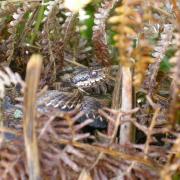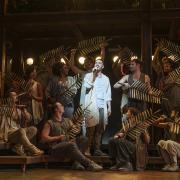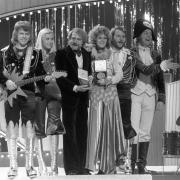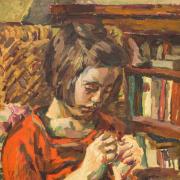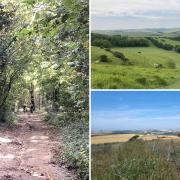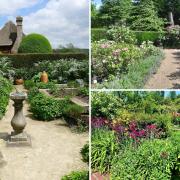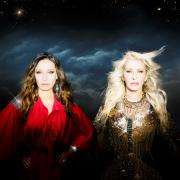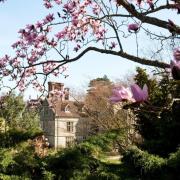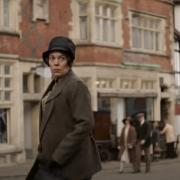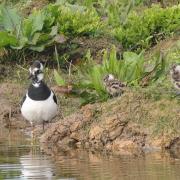Edward Burra is best known for his depictions of urban life and his paintings of Harlem in the 1930s. But this well-travelled artist actually spent most of his life in Rye. Simon Martin of Pallant House Gallery examines the life of a remarkable man.
Sussex as a county has been immensely blessed as the stomping ground of some of the most illustrious Modern British artists: Eric Ravilious and Paul Nash in the South Downs, Duncan Grant and Vanessa Bell at Charleston, Eric Gill and the Ditchling Community, Ivon Hitchens in the Petworth woods, John Piper and Graham Sutherland in Chichester Cathedral, and Adrian Berg in the gardens of Sheffield Park, to name but a few. Yet while Edward Burra (1905 –1976) might have lived for most of his life in the picturesque town of Rye, he would probably have scorned the idea that he was such a thing as a ‘Sussex artist’.
Burra’s father was Chairman of East Sussex County Council, and the large family house Springfield Lodge on the outskirts of Rye looked out over the Sussex landscape, but he always seemed to have one eye directed towards warmer, more exotic locations, such as the South of France, Spain, Mexico and the USA. There is an apocryphal (but quite possibly true) story that in the early 1930s Burra left Springfield to post a letter and returned several weeks later having travelled to New York in the interim period. It was as if he was always looking for some kind of exciting escape from the solidly middle-class existence. Rye in the 1920s and 1930s bore a close similarity to the fictional town of Tilling in the Mapp and Lucia novels by E.F. Benson, a local resident and one-time Mayor. In his witty and acerbic letters to friends Burra gave his quintessentially English hometown the soubriquet ‘Tinkerbelle Towne’. Before the Second World War, the town rarely found its way into Burra’s work, with the notable exception of a painting called Saturday Market (1932, private collection), which depicts the street market outside the Home and Colonial stores. But the racy vision in pink picking her way through the market detritus and scavenging cats, with her outstretched leg and lacy undergarment catching the wandering eye of a market stallholder, is not a typical Rye resident, but rather a Hollywood starlet-cum-Parisian hooker. Burra relished unlikely contrasts, and glamour and squalor appealed to him in equal measure.
Nor does Tea Leaves Overboard (1932, The Frank Cohen Collection) present the picturesque view of Rye that one might expect. Instead it offers a banal and unfamiliar view of a terrace of red brick cottages in Strand Quay, but the foreground is filled with an unconventional view of the deck of a boat with a shipman flushing out a teapot into the River Tillingham. Such quirky details appealed to Burra’s eye for ordinary incident made to look strange. In another work called South West Wind (1932, Portsmouth Museums and Art Gallery), a line of laundry billowing in the wind in front of fishing boats at Hastings takes on the shapes more associated with the forms of continental abstract art. Burra was considered to be a Surrealist artist in the 1930s as he painted strange images of monsters and dancing skeletons, but he generally preferred to maintain his independence from artist groups and styles. At the same time that he was painting extraordinary images influenced by the violence of the Spanish Civil War, or interiors of the opulent churches he had visited on his travels in Mexico, Burra would also occasionally produce more conventional, but stunning landscapes. Cabbages, Springfield, Rye (c.1937, private collection), which shows the view from the rear of Springfield Lodge, differs greatly in style from the landscapes of his contemporaries, such as his friend Paul Nash, or Eric Ravilious and Edward Bawden. These artists simplified the landscape to its essentials – perhaps reflecting the clarity of their poster designs for rail transport and Shell Oil. In contrast Burra was unafraid of depicting every last leaf on the cabbages, producing landscapes that are in no way topographical renditions of place, but reflect his extraordinary memory for detail and are a verdant equivalent to his busy nightclub or market scenes. Virtually all his paintings were created in watercolour instead of oil, perhaps due to the arthritis that plagued him throughout his life. His use of the medium positions him within a English landscape tradition that includes Francis Towne and John Sell Cotman, but Burra’s watercolours have an intensity of colour that is like any other artist’s handling of the medium, a distinctive quality that he put down to his use of spit.
Burra was not sentimental about the landscape, and in later years produced a series of stunning large watercolours of the British landscape resulting from his car trips with his sister Anne. He was unafraid of showing man’s impact on the landscape. English Countryside (1965-67, The Donlea Collection, London) is a view of the rolling Sussex fields crisscrossed with electricity pylons and a main road. Most artists would edit out the less picturesque details, but there is both honesty and beauty to Burra’s view. Although he is perhaps best known for his continental views of bars and caf�s in Paris and New York, it is the late landscapes that have surprised visitors to the exhibition currently on show at Pallant House Gallery in Chichester. While he may have been one of the most unconventional artists in Sussex, Burra undoubtedly deserves to be considered as one of the greatest.
Edward Burra is on show at Pallant House Gallery, Chichester until 19 February 2012. www.pallant.org.uk
Simon Martin is a writer, curator and art historian. He is the Head of Curatorial Services at Pallant House Gallery and the author of the monograph Edward Burra published by Lund Humphries and several other books on Modern British art.



